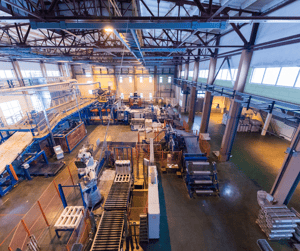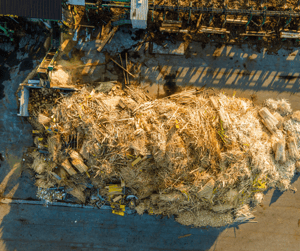Navigating the complexities of hazardous waste management, particularly when it comes to K-listed hazardous wastes, is important for industries committed to both regulatory compliance and sustainable practices.
The Environmental Protection Agency (EPA) mandates that a waste is hazardous if it is specifically listed on one of four lists:
- F listed hazardous wastes
- K listed hazardous wastes
- P listed hazardous wastes
- U listed hazardous wastes
Among these, K-listed hazardous wastes hold a distinctive position. They originate from specific sectors of industry and manufacturing and demand attention to detail in their management and disposal. Understanding the nuances of these waste streams is not only a legal obligation but also a crucial step toward fostering environmentally responsible operations.
K-listed hazardous wastes are considered source-specific wastes. To qualify as a K-listed hazardous waste, the waste must fit into one of 13 categories listed on the EPA’s site and match one of the detailed K-list waste descriptions found in 40-CFR section 261.32.
Because the EPA listings contain more than 400 hazardous wastes, it’s important to know which category the waste your facility generates falls into so you can ensure its proper management and disposal.
13 Industries that Generate K List Waste
The EPA identifies 13 industries that generate K-listed wastes. However, it is important to remember that not all wastes produced by these industries fit the designation of hazardous waste. Hazardous waste streams must meet the elements described in the K list descriptions to qualify under the EPA guidelines.
Here are the 13 industries that qualify for the generation of K-list waste:
- Wood preservation
- Inorganic pigment manufacturing
- Organic chemicals manufacturing
- Inorganic chemicals manufacturing
- Pesticides manufacturing
- Explosives manufacturing
- Petroleum refining
- Iron and steel production
- Primary aluminum production
- Secondary lead processing
- Veterinary pharmaceuticals manufacturing
- Ink formulation
- Coking --processing of coal to produce coke, a material used in iron and steel production
Examples Of K-Listed Hazardous Wastes
There are dozens of hazardous waste types designed as K-listed. Some examples include:
- Wastewater treatment sludges from certain processes such as electroplating, wood preserving and pesticide
 manufacturing
manufacturing - Wood preservation wastes from certain specific processes
- Wastes from certain specific industries, such as organic chemical manufacturing and pesticide manufacturing
- Wastes from certain specific industries, such as wood preserving and pesticide manufacturing
- Wastes from certain specific industries, such as petroleum refining and organic chemical manufacturing
- Spent cyanide plating bath solutions from electroplating operations where cyanides are used in the process
- Spent stripping and cleaning bath solutions from electroplating operations where cyanides are used in the process
- Distillation bottoms from the production of certain specific organic chemicals that contain certain hazardous constituents
- 2,6-Dichlorophenol waste from the production of 2,4-D
- Decanter tank tar sludge from coking operations
- Spent carbon from the treatment of wastewater containing explosives
A full list can be found on the EPA’s site.
Differences Between Waste F, K, P And U Waste Lists
While each of the hazardous wastes featured on these lists have some common traits, there are distinct differences that as a manufacturer are important to know.
The F-list includes wastes from common manufacturing processes across a wide range of industries, such as electroplating, organic chemical manufacturing and wood preserving. These wastes are often byproducts of routine operations and are subject to specific management requirements.
In contrast, the K-list identifies wastes generated from specific industries or processes known to produce hazardous materials. These wastes include sludges, residues and byproducts from activities like metal plating, wood preservation and pesticide manufacturing. Manufacturers must pay close attention to the chemicals used in their processes to determine if they fall under the K-list criteria.
The P-list and U-list, on the other hand, focus on discarded commercial chemical products. The P-list consists of acutely hazardous wastes derived from unused commercial chemical products, while the U-list includes discarded commercial chemical products that are deemed hazardous due to their toxicity, ignitability, corrosivity or reactivity.
Understanding the distinctions between these waste lists is essential for compliance with environmental regulations and ensuring proper handling, storage and disposal of hazardous wastes. Manufacturers must accurately classify their wastes to determine the appropriate management practices and prevent environmental contamination and health risks.
Managing Your K Listed Hazardous Wastes
Effectively managing K-listed hazardous wastes is essential for ensuring regulatory compliance, protecting human health and minimizing environmental impacts. Here are some crucial tips for your company to safely handle, store, transport, treat and dispose of these hazardous materials:
- Identify: First and foremost, accurately identify the hazardous wastes generated by your manufacturing processes to determine if they fall under the K-list criteria. This involves understanding the chemicals used in your operations and their potential hazards.
- Segregate: Implement proper segregation practices to prevent cross-contamination and ensure the integrity of your hazardous waste streams. Separate K-listed wastes from non-hazardous wastes and other hazardous waste streams to facilitate safe handling and disposal.
- Label: Clearly label containers containing K-listed hazardous wastes with appropriate hazard warnings and waste codes. This helps prevent accidents and ensures that personnel handling the waste are aware of its hazardous nature.
- Store: Store K-listed hazardous wastes in designated areas that are secure, well-ventilated and equipped with spill containment measures. Follow applicable regulatory requirements for storage duration and conditions to minimize environmental risks and ensure compliance.
- Train on Handling: Train personnel involved in handling K-listed hazardous wastes on proper handling techniques, including the use of personal protective equipment (PPE) and safe material handling practices. Minimize the generation of dusts, vapors or spills during handling to reduce exposure risks.
- Transport Safely: Follow regulations governing the transportation of hazardous wastes when moving K-listed materials off-site for treatment, recycling or disposal. Use appropriate packaging, labeling and documentation to comply with transportation requirements and prevent accidents or spills during transit. Experienced hazardous waste disposal companies can help ensure the safe transport of these substances to the appropriate facility for incineration, stabilization or landfilling.
- Keep Records: Maintain accurate records of K-listed hazardous waste generation, handling, transportation, treatment and disposal activities. Keep documentation for the required period as specified by regulatory agencies to demonstrate compliance with applicable laws and regulations.
- Ensure Compliance: Regularly review and update your hazardous waste management practices to ensure compliance with evolving regulatory requirements. Conduct periodic inspections and audits to identify and address potential compliance issues proactively.
- Continuously Improve: Implement measures to minimize hazardous waste generation through process optimization, waste reduction strategies and the adoption of cleaner production technologies. Continuously evaluate and improve your hazardous waste management program to enhance environmental performance and reduce liabilities over time.
Understanding and properly managing your K-listed hazardous wastes is crucial not only for regulatory compliance but also for promoting sustainable manufacturing practices. A reputable hazardous waste management company can provide expertise, resources and tailored solutions to assist you with this challenging process, ensuring your business is in compliance and is effectively mitigating the risk to the health and safety of the communities where you do business.


Comment